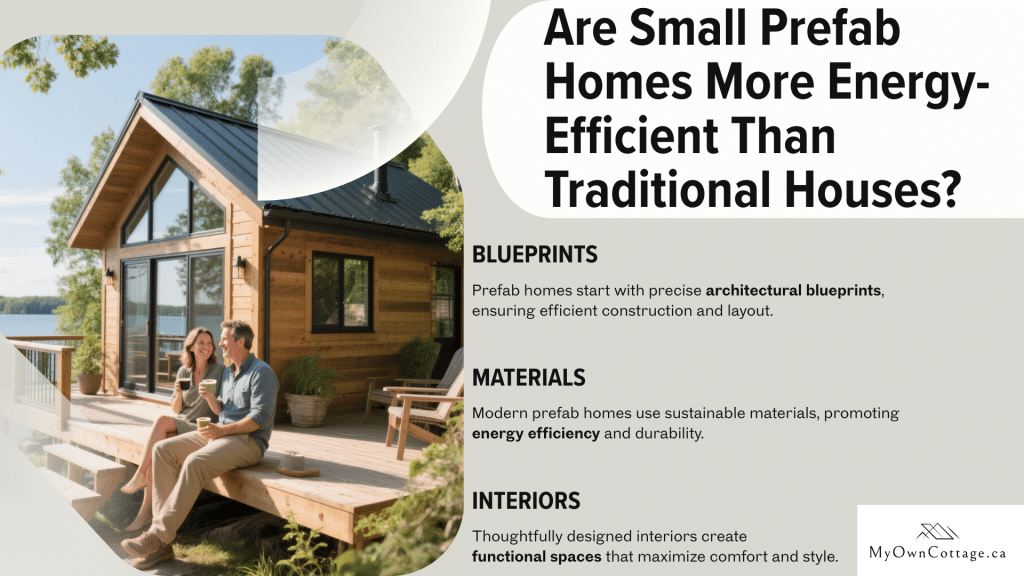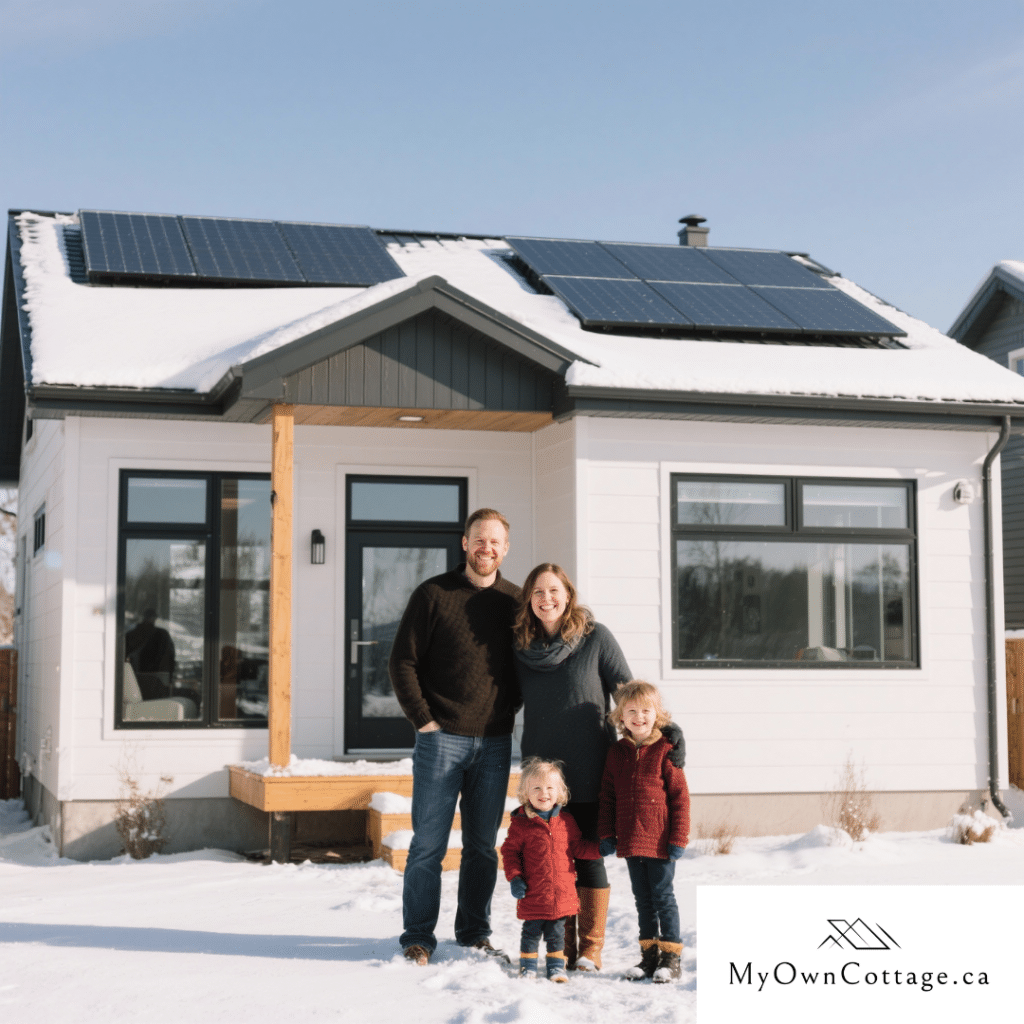Are Prefab Homes Really More Energy-Efficient Than Traditional Houses?
📅 Last updated: September 18th, 2025
✍️ Written by prefab building specialists at My Own Cottage
Across Ontario, rising utility costs and growing environmental awareness have made energy efficiency a top priority for homebuyers.
This raises an important question for families considering a new build: Are Ontario’s small prefab homes really more energy-efficient than traditional houses?

As sustainability becomes a driving force in housing decisions, it’s essential to understand how prefab construction compares to traditional site-built homes.
Critical factors like insulation quality, airtightness, and heating systems directly affect not only your daily comfort but also your long-term energy costs and overall environmental impact.
👉 If you’re ready to see available options, visit our guide to Small Prefab Homes Ontario for Sale.
📌 Key Takeaways: Energy Efficiency of Prefab Homes vs Traditional Houses
Small prefab homes in Ontario typically deliver 20–40% lower energy costs than traditional houses.
Airtight construction and high R-value insulation (R-24 to R-40) cut heating bills by up to 38% in winter.
Over time, energy savings plus government rebates make prefab homes a more affordable, eco-friendly choice for Ontario homeowners.
- Small prefab homes are becoming popular in Ontario due to their numerous advantages
Prefab & Modular Homes in Ontario: The Energy Efficiency Debate
Prefab homes—also known as modular or factory-built homes—are constructed in controlled manufacturing environments before being assembled on-site.
This process delivers consistent quality, tighter construction tolerances, and significantly less material waste.
In contrast, traditional houses are built entirely on-site, where workmanship may be affected by weather delays, fluctuating labor conditions, and less reliable quality control.
In this article, we draw on Canadian housing research, building science insights, and real homeowner experiences to give you a clear, practical comparison.

Our goal is to help you make a confident, well-informed decision about whether a prefab home or a traditionally built house is the right choice for your needs.
🌱 For those new to the space, be sure to learn about how small prefab homes are sold move-in ready or as kits in Ontario.
Key Factors in Energy-Efficient Home Building in Ontario
Energy efficiency in housing refers to how well a building minimizes energy waste while maintaining a comfortable living environment. The key factors that influence efficiency include:
Insulation & Airtightness: A properly sealed building envelope helps retain heat in the winter and keep interiors cool in the summer, minimizing energy loss throughout the year.
Heating & Cooling Systems: High-efficiency HVAC systems and renewable technologies, such as heat pumps, can dramatically reduce household energy use.
Design & Orientation: Compact layouts and strategic placement of windows and rooms help lower overall energy demand.
Performance Standards: In Canada, many energy-efficient homes are built to Energy Star or Net Zero Ready standards, providing measurable, third-party-verified performance.

“Air leakage is one of the biggest sources of wasted energy in Canadian homes. A properly insulated and sealed prefab home can reduce heating demand by up to 25%.” – Dr. John Straube, P.Eng., Building Science Professor
A well-insulated home not only lowers monthly utility bills but also contributes to Canada’s climate goals by cutting greenhouse gas emissions.
🏡 If you’re looking to get started on your own energy-efficient prefab home, be sure to review our guide about the permits required to build a small prefab home in Ontario.
Comparing Prefab Cottages and Traditional Homes for Energy Savings
Small Ontario prefab homes in Ontario are customized and designed with compact layouts that use less energy.
To contrast, our comparisons are based on real-world performance data—not marketing claims. To ensure accuracy, we draw on:
Insulation Values — R-24 to R-40 ratings, verified through manufacturer specifications.
Utility Bill Data — Provided by Ontario homeowners living in both prefab and traditionally built houses.
Government Standards — Benchmarks such as Ontario SB-12 Building Code and Energy Star performance requirements.
Why Small Prefab Homes in Ontario Outperform Traditional Houses
Prefab Construction Standards: Modular Quality & Energy Efficiency
A very common question we hear is, “How long does it take to order and receive a small prefab home in Ontario?“
Unlike traditional site-built homes, prefab houses are manufactured in controlled facilities.
This factory-based method reduces construction waste, improves airtightness, and delivers consistent thermal performance.
Research from the Canadian Home Builders’ Association (CHBA) shows that modular homes often achieve higher energy efficiency test scores due to the precision of factory assembly.
This factory-based approach not only improves energy efficiency but also shortens timelines — as we explore in Are Prefab Modular Homes Faster to Build than Traditional Homes.
Better Insulation & Airtight Construction
Today, Ontario companies offer eco-friendly small prefab homes.
Many of these Energy Star–rated prefab homes outperform traditional stick-built houses because their panels and joints are sealed in controlled factory conditions.
This precision reduces air leaks and enhances insulation—two critical factors for maintaining comfort and lowering heating costs during Ontario’s long, cold winters.
Compact Prefab Homes: Eco-Friendly Designs That Save Energy
By design, small prefab homes in Ontario use less energy.
Their compact layouts require less heating in the winter and less cooling in the summer, which translates into lower utility bills compared to larger, traditionally built houses.
However, bear in mind that you cannot simply put a small prefab homes on any type of property in Ontario.
Prefab vs Traditional Energy Performance
| Factor | Prefab Home | Traditional Home |
|---|---|---|
| Airtightness (ACH50) | 1.5–2.5 | 3.5–5.0 |
| Insulation (R-value) | R-24–R-40 | R-12–R-24 |
| Waste During Construction | <10% | 15–25% |
| Avg. Utility Savings | 20–40% | Baseline |
✅ Many Ontario homeowners report 20–30% lower utility bills in prefab houses compared to traditional homes.
Energy Savings & Cost Benefits of Prefab Homes in Ontario
Lower Utility Bills Over Time
Families living in prefab homes often report annual energy savings of 20–30% compared to traditional houses.
For instance, one homeowner in Northern Ontario noted that after moving into a prefab home, their winter heating bills dropped by nearly 40% compared to their previous site-built house.
Of course, energy use is only one side of the equation — cost per square foot also matters. Learn more in Are Small Prefab Homes More Expensive per Sq Ft With Comparisons.
Government Rebates & Green Incentives in Ontario
There are various financing options available for small prefab homes in Ontario.
In fact, the Canadian government and several Ontario provincial programs provide energy rebates for prefab homes, including grants for heat pump installations and incentives for solar panel integration.
These rebates lower upfront costs and make sustainable housing more accessible and affordable for Ontario homeowners.
Long-Term Value for Resale
More homebuyers are seeking energy-efficient prefab homes in Ontario, as strong energy ratings have become a key factor in resale value.
Homes with lower operating costs and eco-friendly designs not only reduce monthly expenses but also typically command higher market prices.
Common Myths About Prefab Homes vs Eco-Friendly Traditional Houses
Myth 1: Prefab homes are cheaply made
Reality: In Ontario, prefab homes must meet the Ontario Building Code, ensuring durability equal to—and in some cases greater than—site-built houses.
Myth 2: Traditional houses last longer
Reality: Research shows that with proper maintenance, modern prefab homes have a lifespan comparable to traditional builds.
Myth 3: Prefab homes don’t meet energy codes
Reality: Many modular homes not only meet but exceed energy-efficiency requirements. In fact, Net Zero prefab homes in Ontario are setting new benchmarks for sustainability and performance.
Myth 4: Prefab homes can’t have mortgages
Reality: Small prefab homes are eligible for residential mortgages in Ontario. Many institutions now recognize their innate importance in helping to resolve the ongoing housing crisis.
By addressing these misconceptions, buyers can make more confident decisions about the quality, durability, and energy efficiency of prefab construction.
💡 Be sure to review the best places and vendors where you can buy small prefab homes in Ontario.
How the Johnson Family in Ontario Cut Energy Bills by 38% With a Small Prefab Home
Background:
The Johnson family — Mark and Sarah Johnson with their two young children — lived in a 2,400 sq. ft. site-built home in Northern Ontario.
Rising heating bills and drafty rooms made them consider a switch to a more sustainable option.
Challenge:
Winter heating bills averaged $400/month.
Frequent maintenance costs (roof repairs, siding replacements) added to expenses.
Prefab Solution Chosen:
The Johnsons selected a Net Zero Ready prefab home from My Own Cottage.
Key features:
R-32 wall insulation, R-40 roof insulation.
Triple-pane, low-E argon windows.
Heat pump system with HRV.
Airtightness rating of 1.7 ACH50.
Results After One Year:
Heating bills dropped to $250/month (a 38% savings).
Summer cooling costs cut by 30%.
Estimated 2.1 tonnes less CO₂ emitted annually.
Realtor estimated an added 5–7% resale value thanks to strong energy ratings.
5/5 Star Homeowner Review:
⭐️⭐️⭐️⭐️⭐️ “We noticed the comfort right away — no more drafts, no more cold spots. The savings on our first winter heating bill sealed the deal. Moving into our prefab home has been life-changing.” – Sarah Johnson, Northern Ontario

Ontario Prefab Home Energy Savings: Case Studies & Examples
An Ottawa family reported saving more than $1,500 annually on utility costs after moving into a sustainable prefab home equipped with triple-pane windows and advanced insulation.
Research from the Canada Mortgage and Housing Corporation (CMHC) further shows that prefab homes carry a significantly lower carbon footprint than traditional houses, largely due to reduced construction waste and high-performance, energy-efficient designs.
What the Data Shows
A CMHC study found prefab homes produced up to 43% less construction waste compared to traditional builds.
The Canadian Home Builders’ Association reports that modular homes also outperform site-built houses in blower-door airtightness tests, a key measure of energy efficiency.
NRCan data shows Net Zero Ready prefab homes can reduce annual energy demand by up to 80% when paired with renewables.
👉 See available Small Prefab Homes Ontario for Sale for models that meet these criteria.
Why Small Prefab Homes Are Ontario’s Smart Eco-Friendly Housing Choice
Small prefab homes aren’t just affordable and stylish — they’re also designed to be more energy-efficient than many traditional houses.
With airtight construction, advanced insulation, and a reduced carbon footprint, these homes deliver measurable savings and long-term sustainability.
Ready to build your small, energy-efficient prefab home in Ontario?
Get started today by booking a free consultation, calling our team directly, or exploring our design catalogue.
🧑💼 Request a Free Consultation
📲 Call Us Directly: (705) 345-9337
🏘️ View Our Design Catalogue
✅ Ontario-Built | ⚡ Energy-Efficient | 🏡 Fully Customizable | 🚚 Fast Delivery
Alternatively, for your convenience, you can also simply fill out the contact form below and we’ll get back to you soon! 👇
FAQ: About Energy-Efficient Small Prefab Homes Versus Traditional Houses
Why are small prefab homes more energy-efficient?
Prefab construction allows for precision in sealing joints, installing insulation, and controlling air leakage. Because components are manufactured in a factory, builders can enforce tighter tolerances and quality control, which leads to better thermal performance and less energy lost through walls or roofs.
How much energy savings can prefab homes deliver compared to traditional houses?
In Ontario, prefab cottages and homes can reduce energy bills by 25%-50% over comparable traditional houses, primarily due to airtight construction, higher R-value insulation (often R-24 to R-40), and efficient HVAC systems like heat pumps and heat recovery ventilators.
Can prefab homes handle cold Ontario winters effectively?
Yes. Prefab homes built to meet or exceed Ontario’s building codes (including SB-12) often include high-performance insulation, triple- or double-glazed windows, and airtight envelopes that retain heat well, making them perform very well in cold winter climates.
What is the most energy-efficient manufactured home?
The most energy-efficient manufactured homes are Energy Star® certified prefab models that feature airtight construction, high R-value insulation, and triple-pane windows. In Ontario, Net Zero Ready prefab homes represent the highest standard, producing as much energy as they consume when paired with solar panels or renewable systems.
What type of home is the most energy efficient?
Generally, small, well-insulated homes with airtight building envelopes are the most energy efficient. Prefab and modular homes designed to Net Zero or Passive House standards lead the category, using advanced insulation, heat recovery ventilation, and renewable energy systems to minimize energy waste.
What are the advantages of prefabricated homes?
Prefab homes offer faster construction timelines, lower construction waste, and superior energy performance compared to many site-built houses. Buyers benefit from reduced utility bills, government rebates, and the flexibility to integrate green technologies like solar panels and heat pumps. They also tend to provide a smaller carbon footprint and long-term cost savings.
What are the disadvantages of prefabricated homes?
While prefab homes are energy-efficient and cost-effective, potential disadvantages include limited customization with some models, upfront transportation costs, and fewer financing options compared to traditional houses. In certain areas, zoning restrictions or land preparation requirements may also affect placement.
What government rebates or incentives support energy-efficient prefab homes in Ontario?
Ontario offers multiple energy upgrade incentives including:
Home Efficiency Rebate programs for insulation, air sealing, and windows/doors.
The Greener Homes Grant which helps homeowners offset retrofit costs.
Home renovation savings programs covering assessments and rebates on energy-efficient improvements.
Are prefab homes cheaper to run long term compared to traditional houses?
Yes. Although prefab homes may have higher upfront costs, the long-term savings from reduced heating, cooling, and maintenance tend to outweigh those costs. Owners often see lower utility bills and better energy performance, making prefab homes more cost-efficient over time.
What are the main myths about energy efficiency in prefab homes?
Myth: Prefab homes are cheaply built — Reality: They are built to the same or higher structural codes and standards as traditional homes.
Myth: Traditional homes last longer — Reality: Properly built prefab homes with quality materials and maintenance can last 50+ years or more.
Myth: Prefab construction sacrifices comfort — Reality: Airtightness, superior insulation, and modern HVAC ensure consistency in temperature and comfort.
🛡️ Verified Third-Party Resources
For added confidence and transparency, here are trusted external sources that support modular homebuilding in Ontario:
Ontario Building Code (O. Reg. 332/12)
Official provincial regulations that govern modular and factory-built homes.Tarion Warranty Corporation
Provides home warranty coverage and builder licensing in Ontario.Canadian Home Builders’ Association (CHBA)
National organization supporting residential construction, modular certification, and best practices.CMHC – Canada Mortgage and Housing Corporation
Federal housing authority offering insights on modular housing affordability, financing, and energy efficiency.Statistics Canada: Housing Data
Data-driven research on Canadian housing trends, ownership, affordability, and construction.

